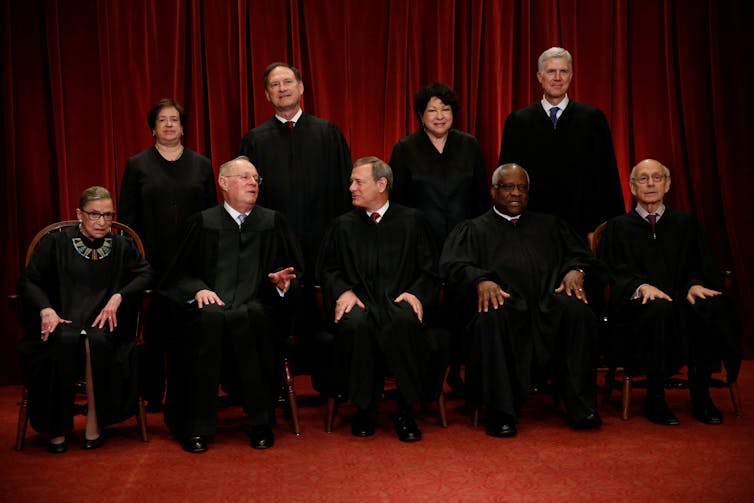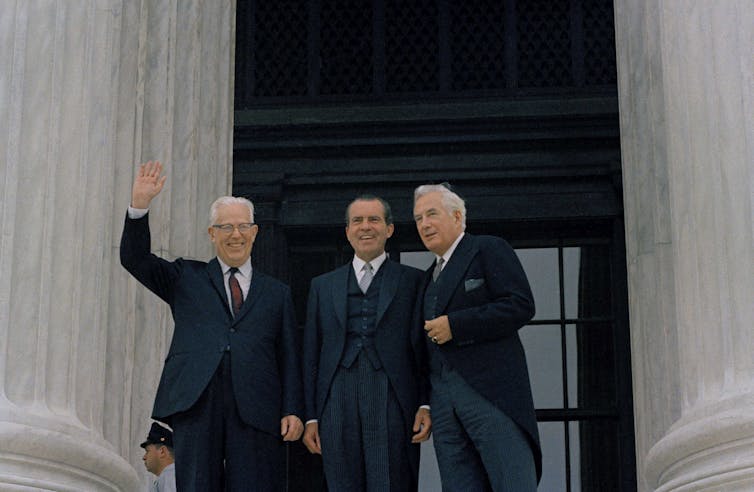Is the Supreme Court's legitimacy undermined in a polarized age?
- Written by Kevin J. McMahon, Professor of Political Science & Director of the Graduate Program in Public Policy, Trinity College
When I learned Justice Anthony Kennedy would retire[1], my thoughts went immediately to the confirmation of the newest justice, Neil Gorsuch.
The Senate’s confirmation of Gorsuch[2] was unprecedented in the history of the country. Never before had a “minority president” named a “minority justice.”
I’m a scholar[3] of the presidency and the Supreme Court. I will soon publish an article in the Chicago-Kent Law Review[4] that considers the concepts of a “minority president” and a “minority justice” in relation to presidential appointments to the High Court for much of American history.
Here’s what I mean by these terms.
Court out of step with America?
Since Donald Trump lost the popular vote[5] in the 2016 election, he is, by definition, a minority president, elected by a minority of the voters.
Similarly, I define a “minority justice” as a nominee who won confirmation with the support of a majority of senators, but senators who did not represent a majority of voters.
Consider Gorsuch. He was supported by a majority of senators – 51 Republicans and three Democrats[6]. But the votes earned by those 54 senators only added up to a total of 54,098,387[7].
The 45 senators who opposed Gorsuch, all Democrats, collected 73,425,062[8] votes in their most recent elections – a nearly 20 million-vote difference.
There are now three Supreme Court justices – Clarence Thomas, Samuel Alito and Gorsuch – that fit the description of a “minority justice.” And they are the only three in the nation’s history.
Now, there is a possibility of a fourth “minority justice” – the second appointed by a “minority president.”
That raises a question that goes to the heart of the Supreme Court’s legitimacy in our democracy: Will this be a court out of line with America?
If so, what might that mean for the country’s politics and law? Indeed, for the nation itself?
Seldom far from the mainstream
To be sure, the framers of the Constitution purposely decided to provide each state with two senators[9], knowing that those senators from states with smaller populations would represent fewer – at times far fewer – citizens than those with larger ones. Today, for example, California’s population is close to 40 million while Wyoming’s is less than 600,000. Yet both states have two senators.
This arrangement was a central aspect of the Great Compromise,[10] which helped convince representatives from sparsely populated states — fearful of being ignored by an alliance of the heavily populated states — to back the new Constitution.
 The current Supreme Court: Retiring Justice Kennedy is second from left, bottom row.
REUTERS/Jonathan Ernst
The current Supreme Court: Retiring Justice Kennedy is second from left, bottom row.
REUTERS/Jonathan Ernst
Nevertheless, since the popular vote began to matter in the election of 1824, a minority president had never succeeded in appointing a minority justice. Indeed, until this century, even for presidents who won the popular vote by a large margin, significant Senate resistance more often than not doomed a nominee to the court[11].
This might help to explain why political scientist Robert McCloskey concluded[12] in 1960 that the court had rarely “lagged far behind nor forged far ahead of America” and that the justices had “seldom strayed very far from the mainstreams of American life.”
Might politics and the courts collide?
Things are different today. We live in a period of deep political polarization[13]. This shift in American politics raises some important questions about the Supreme Court’s legitimacy in our democracy.
In the past, political majorities at the polls have supported significant doctrinal shifts by the court, even if the specific rulings have been controversial.
In other words, as McCloskey and fellow political scientist Robert Dahl observed, since one party typically dominated during an extended period of time, the justices – because they were products of that enduring regime – generally advanced the regime’s interests in the long term. To put it simply, for much of American history, the court followed the election returns.[14]
For example, the 1905 decision of Lochner v. New York[15], which struck down state legislation designed to protect workers via the court’s freedom of contract doctrine[16], was a product of the Republican regime that dominated American politics at the time.
Similarly, the New Deal Democratic regime[17] ushered in by the landslide election of Franklin D. Roosevelt in 1932 ultimately provided the political basis for another divisive decision, Brown v. Board of Education[18], which found that supposedly “separate-but-equal” segregated schools were unconstitutional[19].
Today, no such majority exists.
The popular vote for president and the Electoral College results have twice in the last five presidential elections been out of alignment[20]. And the Democratic presidential nominee has won the popular vote[21] in six of the last seven presidential elections (from 1992 to 2016), yet Republican presidents have appointed a majority[22] of the sitting justices.
Given this recent divide between the popular vote and the electoral vote, it seems reasonable to consider the possibility of the alternative to McCloskey’s conclusions – of a court that consistently diverges from American majorities on the most pressing issues of the day.
After all, Supreme Court justices have lifetime appointments[23] and typically stay on the bench for many years, even decades. Their imprint on the law can be enduring and their legitimacy, conferred in part by the confirmation process, helps ensure their place in our democracy.
With the addition of a second Trump justice, many court observers suspect the 1973 ruling, known popularly as the “Roe” case[24], which affirms women’s right to terminate an unwanted pregnancy, will be a prime target of the conservative majority.
Will Roe stand?
While Roe has been a deeply divisive decision since the day it was announced, the Republican in the White House at the time — Richard Nixon — neither publicly denounced it[25] nor sought to overturn it[26]. And three of his four appointees to the court joined the 7-2 majority[27], including the opinion’s author Justice Harry Blackmun[28].
 President Nixon, flanked by outgoing Chief Justice Earl Warren, left, and incoming Chief Justice Warren Burger, right.
AP Photo
President Nixon, flanked by outgoing Chief Justice Earl Warren, left, and incoming Chief Justice Warren Burger, right.
AP Photo
Of course, Nixon’s Republican successor, Ronald Reagan, oversaw a Justice Department that repeatedly asked the Court to reverse itself on Roe[29]. But ultimately a majority of the justices refused to go along, including two of Reagan’s three additions to the court, Sandra Day O'Connor and the now departing Anthony Kennedy.
Today, polls show significant opposition to overturning the decision.
For example, according to a recent Kaiser Family Foundation poll[30], 67 percent of Americans are opposed to the Court doing so, including 43 percent of Republicans. A Quinnipiac poll[31] supported this conclusion, finding 63 percent of respondents agreed with Roe while just 31 percent did not.
It would be best if a court making a determination on the future of Roe could do so with the utmost legitimacy. But given the state of our politics today, that is a near impossibility.
According to the same Quinnipiac poll[32], a majority of Americans already believe that the court reaches its rulings based mainly on politics rather than law – 50 versus 42 percent.
A conservative court that quickly discards Roe will likely further that belief, given the central role opponents of the decision have played in mobilizing voters to support Republican candidates like Donald Trump. The result may be a further erosion of the court’s legitimacy, and a deepening of the partisan divide in America.
References
- ^ would retire (www.nytimes.com)
- ^ confirmation of Gorsuch (www.nytimes.com)
- ^ I’m a scholar (internet2.trincoll.edu)
- ^ the Chicago-Kent Law Review (studentorgs.kentlaw.iit.edu)
- ^ lost the popular vote (www.politifact.com)
- ^ 51 Republicans and three Democrats (www.nytimes.com)
- ^ 54,098,387 (uselectionatlas.org)
- ^ 73,425,062 (uselectionatlas.org)
- ^ each state with two senators (www.senate.gov)
- ^ Great Compromise, (www.senate.gov)
- ^ doomed a nominee to the court (www.loc.gov)
- ^ Robert McCloskey concluded (books.google.com)
- ^ deep political polarization (www.people-press.org)
- ^ election returns. (heinonline.org)
- ^ Lochner v. New York (www.oyez.org)
- ^ freedom of contract doctrine (constitutioncenter.org)
- ^ New Deal Democratic regime (www.history.com)
- ^ Brown v. Board of Education (www.oyez.org)
- ^ were unconstitutional (press.uchicago.edu)
- ^ been out of alignment (www.latimes.com)
- ^ won the popular vote (ropercenter.cornell.edu)
- ^ appointed a majority (www.supremecourt.gov)
- ^ have lifetime appointments (www.uscourts.gov)
- ^ the “Roe” case (supreme.justia.com)
- ^ neither publicly denounced it (www.nytimes.com)
- ^ sought to overturn it (press.uchicago.edu)
- ^ joined the 7-2 majority (landmarkcases.org)
- ^ author Justice Harry Blackmun (prospect.org)
- ^ Roe (www.emeraldinsight.com)
- ^ Kaiser Family Foundation poll (www.kff.org)
- ^ A Quinnipiac poll (poll.qu.edu)
- ^ same Quinnipiac poll (poll.qu.edu)
Authors: Kevin J. McMahon, Professor of Political Science & Director of the Graduate Program in Public Policy, Trinity College
Read more http://theconversation.com/is-the-supreme-courts-legitimacy-undermined-in-a-polarized-age-99473

